McCulloch MC1136, MC1136B User Manual
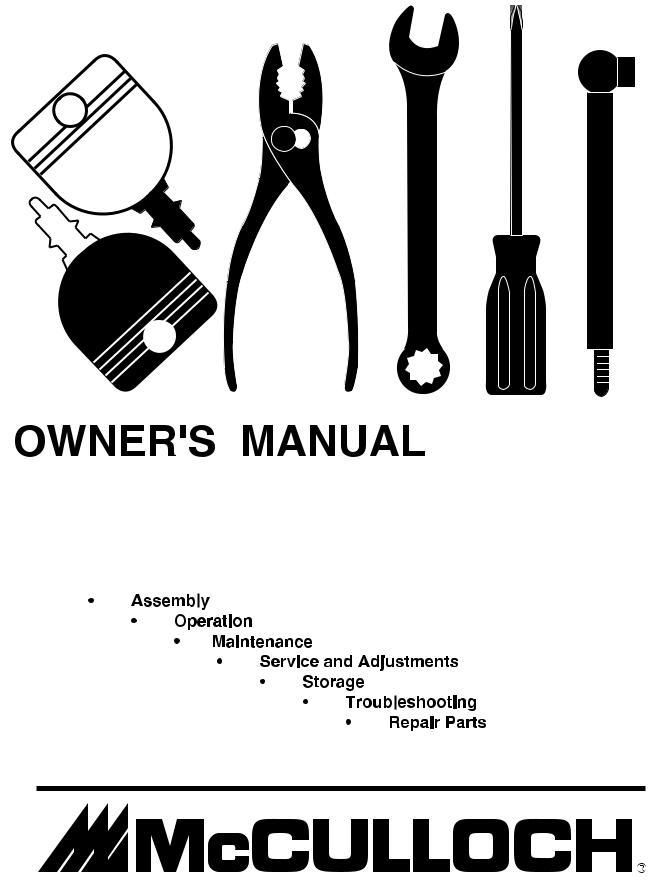
MODEL NO. MC1136 (MC1136B)
11 HP 36 Inch
Lawn Tractor
532 19 38-89 Rev. 1 9.15.04 RD
PRINTED IN U.S.A.
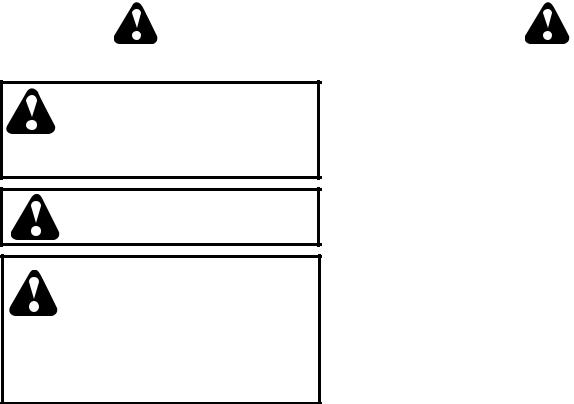
SAFETY RULES
Safe Operation Practices for Ride-On Mowers
IMPORTANT: THIS CUTTING MACHINE IS CAPABLE OF AMPUTATING HANDS AND FEET AND THROWING OBJECTS. FAILURE TO OBSERVE THE FOLLOWING SAFETY INSTRUCTIONS COULD RESULT IN SERIOUS INJURY OR DEATH.
WARNING: In order to prevent accidental starting when setting up, transporting, adjusting or making repairs, always disconnect spark plug wire and place wire where it cannot contact spark plug.
WARNING: Do not coast down a hill in neutral, you may lose control of the tractor.
WARNING: Tow only the attachments that are recommended by and comply with specifications of the manufacturer of your tractor. Use common sense when towing. Operate only at the lowest possible speed when on a slope. Too heavy of a load, while on a slope, is dangerous. Tires can lose traction with the ground and cause you to lose control of your tractor.
I. GENERAL OPERATION
•Read, understand, and follow all instructions on the machine and in the manual before starting.
•Do not put hands or feet near rotating parts or under the machine. Keep clear of the discharge opening at all times.
•Only allow responsible adults, who are familiar with the instructions, to operate the machine.
•Clear the area of objects such as rocks, toys, wire, etc., which could be picked up and thrown by the blades.
•Be sure the area is clear of bystanders before operating. Stop machine if anyone enters the area.
•Never carry passengers.
•Do not mow in reverse unless absolutely necessary. Always look down and behind before and while backing.
•Never direct discharged material toward anyone. Avoid discharging material against a wall or obstruction. Material may ricochet back toward the operator. Stop the blades when crossing gravel surfaces.
•Do not operate machine without the entire grass catcher, discharge guard, or other safety devices in place and working.
•Slow down before turning.
•Never leave a running machine unattended. Always turn off blades, set parking brake, stop engine, and remove keys before dismounting.
•Disengage blades when not mowing. Shut off engine and wait for all parts to come to a complete stop before cleaning the machine, removing the grass catcher, or unclogging the discharge guard.
•Operate machine only in daylight or good artificial light.
•Do not operate the machine while under the influence of alcohol or drugs.
•Watch for traffic when operating near or crossing roadways.
•Use extra care when loading or unloading the machine into a trailer or truck.
•Always wear eye protection when operating machine.
•Data indicates that operators, age 60 years and above, are involved in a large percentage of riding mower-re- lated injuries. These operators should evaluate their ability to operate the riding mower safely enough to protect themselves and others from serious injury.
•Follow the manufacturer's recommendation for wheel weights or counterweights.
•Keep machine free of grass , leaves or other debris build-up which can touch hot exhaust / engine parts and burn. Do not allow the mower deck to plow leaves or other debris which can cause build-up to occur. Clean any oil or fuel spillage before operating or storing the machine. Allow machine to cool before storage.
II. SLOPE OPERATION
Slopes are a major factor related to loss of control and tip-over accidents, which can result in severe injury or death. Operation on all slopes requires extra caution. If you cannot back up the slope or if you feel uneasy on it, do not mow it.
•Mow up and down slopes, not across.
•Watch for holes, ruts, bumps, rocks, or other hidden objects. Uneven terrain could overturn the machine. Tall grass can hide obstacles.
•Choose a low ground speed so that you will not have to stop or shift while on the slope.
•Do not mow on wet grass. Tires may lose traction. Always keep the machine in gear when going down slopes. Do not shift to neutral and coast downhill.
•Avoid starting, stopping, or turning on a slope. If the tires lose traction, disengage the blades and proceed slowly straight down the slope.
•Keep all movement on the slopes slow and gradual. Do not make sudden changes in speed or direction, which could cause the machine to roll over.
•Use extra care while operating machine with grass catchers or other attachments; they can affect the stability of the machine. Do no use on steep slopes.
•Do not try to stabilize the machine by putting your foot on the ground.
•Do not mow near drop-offs, ditches, or embankments. The machine could suddenly roll over if a wheel is over the edge or if the edge caves in.
2
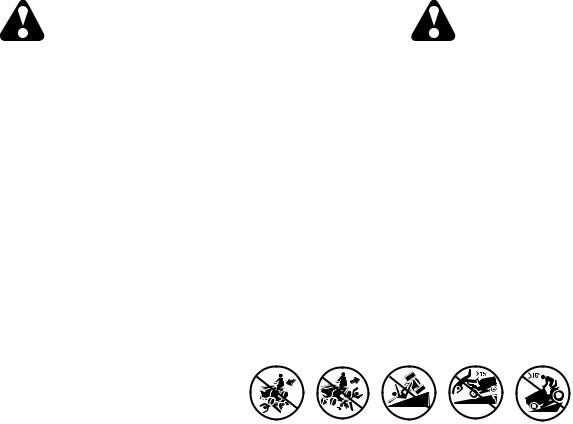
SAFETY RULES
Safe Operation Practices for Ride-On Mowers
III. CHILDREN
Tragic accidents can occur if the operator is not alert to the presence of children. Children are often attracted to the machine and the mowing activity. Never assume that children will remain where you last saw them.
•Keep children out of the mowing area and in the watchful care of a responsible adult other than the operator.
•Be alert and turn machine off if a child enters the area.
•Before and while backing, look behind and down for small children.
•Never carry children, even with the blades shut off. They may fall off and be seriously injured or interfere with safe machine operation.Children who have been given rides in the past may suddenly appear in the mowing area for another ride and be run over or backed over by the machine.
•Never allow children to operate the machine.
•Use extra care when approaching blind corners, shrubs, trees, or other objects that may block your view of a child.
IV. TOWING
GENERAL SERVICE
•Never operate machine in a closed are.
•Keep all nuts and bolts tight to be sure the equipment is in safe working condition.
•Never tamper with safety devices. Check their proper operation regularly.
•Keep machine free of grass, leaves, or other debris build-up. Clean oil or fuel spillage and remove any fuelsoaked debris. Allow machine to cool before storing.
•If you strike a foreign object, stop and inspect the machine. Repair, if necessary, before restarting.
•Never make any adjustments or repairs with the engine running.
•Check grass catcher components and the discharge guard frequently and replace with manufacturer's recommended parts, when necessary.
•Mower blades are sharp. Wrap the blade or wear gloves, and use extra caution when servicing them.
•Check brake operation frequently. Adjust and service as required.
•Maintain or replace safety and instruction labels, as necessary.
•Tow only with a machine that has a hitch designed for towing. Do not attach towed equipment except at the hitch point.
•Follow the manufacturer's recommendation for weight limits for towed equipment and towing on slopes.
•Never allow children or others in or on towed equipment.
•On slopes, the weight of the towed equipment may cause loss of traction and loss of control.
•Travel slowly and allow extra distance to stop.
V. SERVICE
SAFE HANDLING OF GASOLINE
To avoid personal injury or property damage, use extreme care in handling gasoline. Gasoline is extremely flammable and the vapors are explosive.
•Extinguish all cigarettes, cigars, pipes, and other sources of ignition.
•Use only approved gasoline container.
•Never remove gas cap or add fuel with the engine running. Allow engine to cool before refueling.
•Never fuel the machine indoors.
•Never store the machine or fuel container where there is an open flame, spark, or pilot light such as on a water heater or other appliances.
•Never fill containers inside a vehicle or on a truck or trailer bed with plastic liner. Always place containers on the ground away from your vehicle when filling.
•Remove gas-powered equipment from the truck or trailer and refuel it on the ground. If this is not possible, then refuel such equipment with a portable container, rather than from a gasoline dispenser nozzle.
•Keep the nozzle in contact with the rim of the fuel tank or container opening at all times until fueling is complete. Do not use a nozzle lock-open device.
•If fuel is spilled on clothing, change clothing immediately.
•Never overfill fuel tank. Replace gas cap and tighten securely.
•Be sure the area is clear of bystanders before operating. Stop machine if anyone enters the area.
•Never carry passengers.
•Do not mow in reverse unless absolutely necessary. Always look down and behind before and while backing.
•Never carry children, even with the blades shut off. They may fall off and be seriously injured or interfere with safe machine operation.Children who have been given rides in the past may suddenly appear in the mowing area for another ride and be run over or backed over by the machine.
•Keep children out of the mowing area and in the watchful care of a responsible adult other than the operator.
•Be alert and turn machine off if a child enters the area.
•Before and while backing, look behind and down for small children.
•Mow up and down slopes (15° Max), not across.
•Be alert and turn machine off if a child enters the area.
•Choose a low ground speed so that you will not have to stop or shift while on the slope.
•Avoid starting, stopping, or turning on a slope. If the tires lose traction, disengage the blades and proceed slowly straight down the slope.
•If machine stops while going uphill, disengage blades, shift into reverse and back down slowly.
•Do not turn on slopes unless necessary, and then, turn slowly and gradually downhill, if possible.
3

PRODUCT SPECIFICATIONS
Gasoline Capacity |
1.25 Gallons |
|
and type: |
Unleaded Regular |
|
|
|
|
Oil Type |
SAE 30 (above 32°F) |
|
(API-SG-SL): |
SAE 5W-30 (below 32°F) |
|
Oil Capacity: |
3 Pints |
|
|
|
|
Spark Plug: |
Champion RC12YC |
|
(Gap: .030") |
|
|
Ground Speed (MPH): |
Forward: |
|
|
1st |
1.1 |
|
2nd |
2.2 |
|
3rd |
3.3 |
|
4th |
4.9 |
|
Reverse: |
1.4 |
|
|
|
Tire Pressure: |
Front: |
14 PSI |
|
Rear: |
12 PSI |
|
|
|
Charging System: |
3 Amps Battery |
|
|
5 Amps Headlights |
|
Battery: |
AMP/HR: |
28 |
|
MIN. CCA: |
230 |
|
Case Size: |
U1R |
|
|
|
Blade Bolt Torque: |
27-35 FT. LBS. |
|
CONGRATULATIONS on your purchase of a new tractor. It has been designed, engineered and manufactured to give you the best possible dependability and performance.
Should you experience any problem you cannot easily remedy, please contact your nearest authorized service center/ department. We have competent, well-trained technicians and the proper tools to service or repair this tractor.
Please read and retain this manual. The instructions will enable you to assemble and maintain your tractor properly. Always observe the “SAFETY RULES”.
CUSTOMER RESPONSIBILITIES
•Read and observe the safety rules.
•Follow a regular schedule in maintaining, caring for and using your tractor.
•Follow the instructions under “Maintenance” and “Storage” sections of this owner’s manual.
WARNING: This tractor is equipped with an internal combustion engine and should not be used on or near any unimproved forest-covered, brush-covered or grass-covered land unless the engine’s exhaust system is equipped with a spark arrester meeting applicable local or state laws (if any). If a spark arrester is used, it should be maintained in effective working order by the operator.
A spark arrester for the muffler is available through your nearest authorized service center/department (See REPAIR PARTS section of this manual).
TABLE OF CONTENTS
SAFETY RULES ......................................................... |
2-3 |
PRODUCT SPECIFICATIONS ....................................... |
4 |
CUSTOMER RESPONSIBILITIES................................. |
4 |
ASSEMBLY ................................................................. |
6-8 |
OPERATION ............................................................. |
9-13 |
MAINTENANCE SCHEDULE ...................................... |
14 |
MAINTENANCE ..................................................... |
14-17 |
SERVICE AND ADJUSTMENTS ............................ |
18-22 |
STORAGE .................................................................... |
23 |
TROUBLESHOOTING ............................................ |
24-25 |
REPAIR PARTS ...................................................... |
28-41 |
4
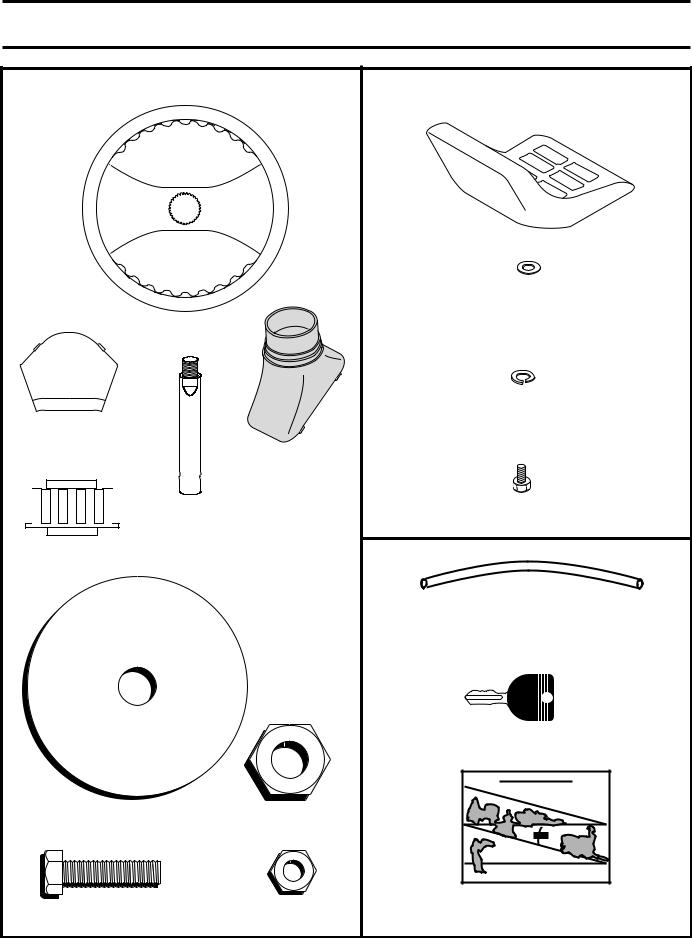
UNASSEMBLED PARTS
|
|
Steering Wheel |
Seat |
|
|
|
|
|
(1) Washer |
|
|
|
|
17/32 x 1-3/16 x 12 Gauge |
|
|
|
|
(1) Lock |
Steering Wheel |
|
Washer 1/2 |
||
|
|
|||
Insert |
|
|
Steering |
|
|
|
|
||
|
|
|
Boot |
|
|
|
Steering |
|
(1) Bolt |
|
|
Extension |
|
|
Steering Wheel |
Shaft |
|
|
|
|
|
|
||
Adapter |
|
|
|
|
|
|
|
|
(1) Oil Drain Tube |
|
|
|
|
For Future Use |
|
|
|
|
Keys |
|
|
|
|
(2) Keys |
|
|
|
|
Slope Sheet |
(1) Large Flat Washer |
(1) Locknut |
1/2-20 |
||
(1) Hex Bolt |
1/4-28 x 1-1/4 |
(1) Locknut |
1/4-28 |
|
|
|
|
|
5 |
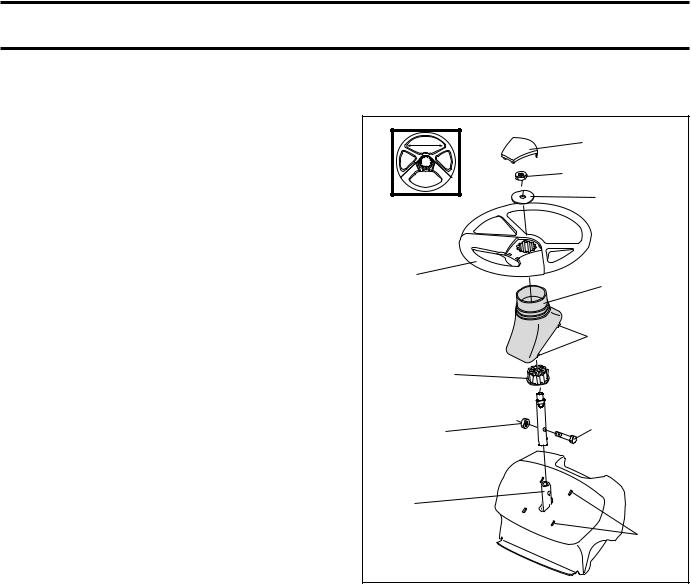
ASSEMBLY
Your new tractor has been assembled at the factory with exception of those parts left unassembled for shipping purposes. To ensure safe and proper operation of your tractor all parts and hardware you assemble must be tightened securely. Use the correct tools as necessary to insure proper tightness.
TOOLS REQUIRED FOR ASSEMBLY
A socket wrench set will make assembly easier. Standard wrench sizes are listed.
(2) |
7/16" wrenches |
Pliers |
(1) |
3/4" wrench |
Tire pressure gauge |
Utility knife
When right or left hand is mentioned in this manual, it means when you are in the operating position (seated behind the steering wheel).
TO REMOVE TRACTOR FROM CARTON
UNPACK CARTON
•Remove all accessible loose parts and parts cartons from carton.
•Cut along dotted lines on all four panels of carton. Remove end panels and lay side panels flat.
•Check for any additional loose parts or cartons and remove.
INSERT
1/2 HEX NUT
LARGE FLAT
WASHER
STEERING
WHEEL
STEERING BOOT
TABS
ADAPTER
 EXTENSION SHAFT
EXTENSION SHAFT
1/4 LOCKNUT |
1/4 HEX BOLT |
|
BEFORE REMOVING TRACTOR FROM SKID
ATTACH STEERING WHEEL (See Fig. 1)
ASSEMBLE EXTENSION SHAFT AND BOOT
•Slide extension shaft onto lower steering shaft. Align mounting holes in extension and lower shafts and install 1/4 hex bolt and locknut. Tighten securely.
IMPORTANT: TIGHTEN BOLT AND NUT SECURELY TO 10-12 FT. LBS TORQUE.
•Place tabs of steering boot over tab slots in dash and push down to secure.
INSTALL STEERING WHEEL
•Position front wheels of the tractor so they are pointing straight forward.
•Remove steering wheel adapter from steering wheel and slide adapter onto steering shaft extension.
•Position steering wheel so cross bars are horizontal (left to right) and slide inside boot and onto adapter.
•Assemble large flat washer, 1/2 hex nut and tighten securely.
•Snap steering wheel insert into center of steering wheel.
•Remove protective materials from tractor hood and grill.
IMPORTANT: CHECK FOR AND REMOVE ANY STAPLES IN SKID THAT MAY PUNCTURE TIRES WHERE TRACTOR IS TO ROLL OFF SKID.
LOWER
STEERING
SHAFT
FIG. 1
0259 |
7 |
|
TAB SLOTS
6
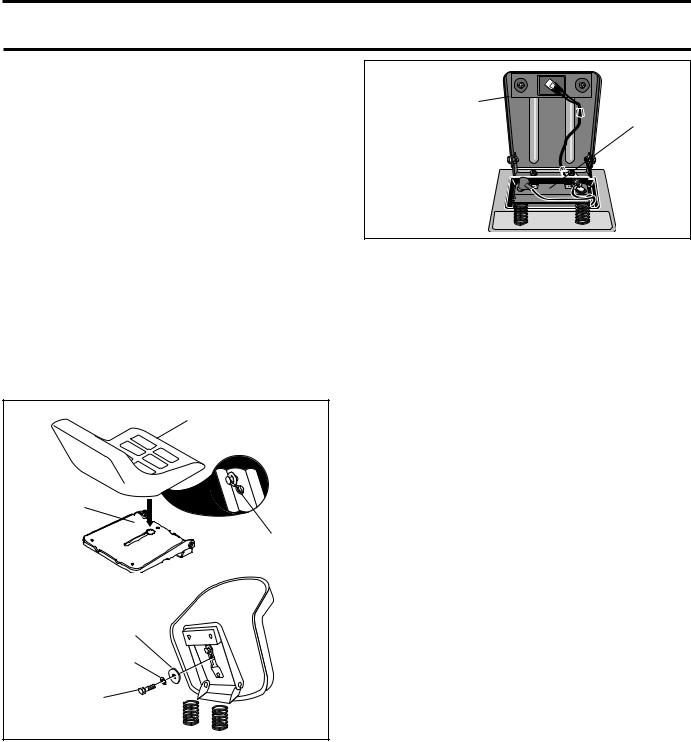
ASSEMBLY
HOW TO SET UP YOUR TRACTOR
INSTALL SEAT (See Fig. 2)
Adjust seat before tightening adjustment bolt.
•Remove adjustment bolt, lock washer and flat washer securing seat to cardboard packing and set aside for assembly of seat to tractor.
•Pivot seat upward and remove from the cardboard packing. Remove the cardboard packing and discard.
•Place seat on seat pan so head of shoulder bolt is positioned over large slotted hole in pan.
•Push down on seat to engage shoulder bolt in slot and pull seat towards rear of tractor.
•Pivot seat and pan forward and assemble adjustment bolt, lockwasher and flat washer loosely. Do not tighten
•Lower seat into operating position and sit on seat.
•Slide seat until a comfortable position is reached which allows you to press clutch/brake pedal all the way down.
•Get off seat without moving its adjusted position.
•Raise seat and tighten adjustment bolt securely.
SEAT
SEAT PAN
SHOULDER
BOLT
66
FLAT WASHER
LOCK WASHER
ADJUSTMENT |
|
BOLT |
02465 |
|
FIG. 2
CHECK BATTERY (See Fig. 3)
•Lift seat pan to raised position.
•If this battery is put into service after month and year indicated on label (label located between terminals) charge battery for minimum of one hour at 6-10 amps. (See “BATTERY” in the Maintenance section of this
manual for charging instructions).
SEAT PAN
LABEL
02602
FIG. 3
NOTE: You may now roll or drive your tractor off the skid. Follow the appropriate instruction below to remove the tractor from the skid.
TO ROLL TRACTOR OFF SKID (See Operation section for location and function of controls)
•Press lift lever plunger and raise attachment lift lever to its highest position.
•Release parking brake by depressing clutch/brake pedal.
•Place gearshift lever in neutral (N) position.
•Roll tractor forward off skid.
•Remove banding holding deflector shield up against tractor.
TO DRIVE TRACTOR OFF SKID (See Operation section for location and function of controls)
 WARNING: Before starting, read, understand and follow all instructions in the Operation section of this manual. Be sure tractor is in a well-ventilated area. Be sure the area in front of tractor is clear of other people and objects.
WARNING: Before starting, read, understand and follow all instructions in the Operation section of this manual. Be sure tractor is in a well-ventilated area. Be sure the area in front of tractor is clear of other people and objects.
•Be sure all the above assembly steps have been completed.
•Check engine oil level and fill fuel tank with gasoline.
•Sit on seat in operating position, depress clutch/brake pedal and set the parking brake.
•Place gear shift lever in neutral (N) position.
•Press lift lever plunger and raise attachment lift lever to its highest position.
•Start the engine.After engine has started, move throttle control to idle position.
•Depress clutch/brake pedal into full "BRAKE" position and hold. Move gearshift lever to 1st gear.
•Slowly release clutch/brake pedal and slowly drive tractor off skid.
•Apply brake to stop tractor, set parking brake and place gearshift lever in neutral position.
•Turn ignition key to "OFF" position.
Continue with the instructions that follow.
7

ASSEMBLY
CHECK TIRE PRESSURE
The tires on your tractor were overinflated at the factory for shipping purposes. Correct tire pressure is important for best cutting performance.
•Reduce tire pressure to PSI shown in “PRODUCT SPECIFICATIONS” section of this manual.
CHECK DECK LEVELNESS
For best cutting results, mower housing should be properly leveled. See“TO LEVEL MOWER HOUSING”in the Service and Adjustments section of this manual.
CHECK FOR PROPER POSITION OF ALL BELTS
See the figures that are shown for replacing motion and mower blade drive belts in the Service and Adjustments section of this manual. Verify that the belts are routed correctly.
CHECK BRAKE SYSTEM
After you learn how to operate your tractor, check to see that the brake is properly adjusted. See “TO ADJUST BRAKE” in the Service and Adjustments section of this manual.
CHECKLIST
BEFOREYOU OPERATE AND ENJOYYOUR NEW TRACTOR, WE WISH TO ASSURE THAT YOU RECEIVE THE BEST PERFORMANCE AND SATISFACTION FROMTHIS QUALITY PRODUCT.
PLEASE REVIEW THE FOLLOWING CHECKLIST:
All assembly instructions have been completed.
No remaining loose parts in carton.
Battery is properly prepared and charged. (Minimum 1 hour at 6 amps).
Seat is adjusted comfortably and tightened securely.
All tires are properly inflated. (For shipping purposes, the tires were overinflated at the factory).
Be sure mower deck is properly leveled side-to-side/ front-to-rear for best cutting results. (Tires must be properly inflated for leveling).
Check mower and drive belts. Be sure they are routed properly around pulleys and inside all belt keepers.
Check wiring. See that all connections are still secure and wires are properly clamped.
WHILE LEARNING HOW TO USE YOUR TRACTOR, PAY EXTRA ATTENTION TO THE FOLLOWING IMPORTANT ITEMS:
Engine oil is at proper level.
Fuel tank is filled with fresh, clean, regular unleaded gasoline.
Become familiar with all controls - their location and function. Operate them before you start the engine.
Be sure brake system is in safe operating condition.
8
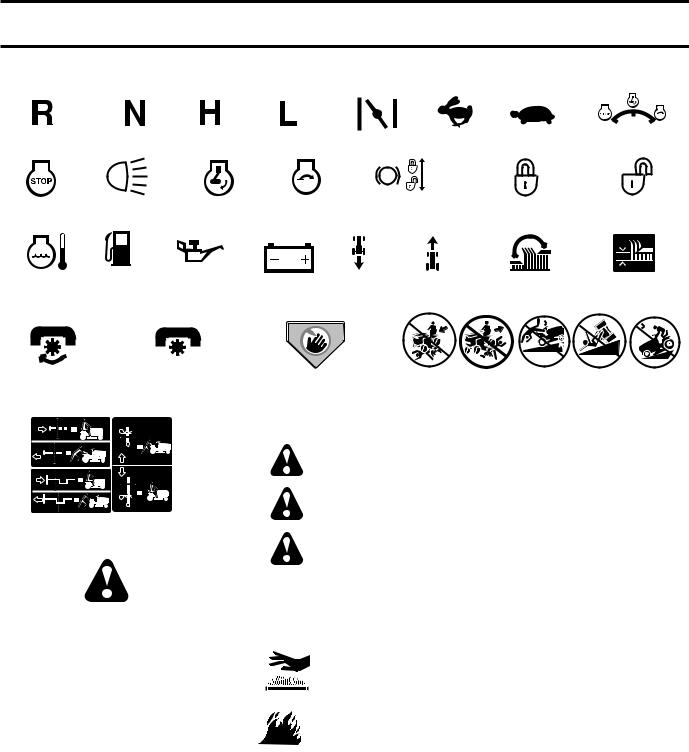
OPERATION
These symbols may appear on your tractor or in literature supplied with the product. Learn and understand their meaning.
REVERSE |
NEUTRAL |
HIGH |
LOW |
CHOKE |
FAST |
|
SLOW |
IGNITION |
|
|
|
|
|
|
P |
|
|
|
|
ENGINE OFF |
LIGHTS ON |
|
ENGINE ON |
ENGINE START PARKING BRAKE |
PARKING BRAKE |
PARKING BRAKE |
|||
|
|
|
|
|
|
|
LOCKED |
UNLOCKED |
|
OVER TEMP |
FUEL |
OIL PRESSURE |
BATTERY |
REVERSE |
FORWARD |
MOWER HEIGHT |
MOWER LIFT |
||
LIGHT |
|
|
|
|
|
|
|
|
|
|
|
|
|
|
|
|
|
15 |
15 |
|
|
|
|
|
|
|
|
|
|
ATTACHMENT |
ATTACHMENT |
DANGER, KEEP HANDS |
KEEP AREA CLEAR |
SLOPE HAZARDS |
|||||
CLUTCH ENGAGED CLUTCH DISENGAGED |
|||||||||
|
|
|
|
AND FEET AWAY |
(SEE SAFETY RULES SECTION) |
||||
FREE WHEEL (Automatic Models only)
Failure to follow instructions could result in serious injury or death. The safety alert symbol is used to identify safety information about hazards which can result in death, serious injury and/or property damage.
DANGER indicates a hazard which, if not avoided, will result in death or serious injury.
WARNING indicates a hazard which, if not avoided, could result in death or serious injury.
CAUTION indicates a hazard which, if not avoided, might result in minor or moderate injury.
CAUTION when used without the alert symbol, indicates a situation that could result in damage to the tractor and/or engine.
HOT SURFACES indicates a hazard which,
if not avoided, could result in death, serious injury and/or property damage.
FIRE indicates a hazard which, if not avoided, could result in death, serious injury and/or property damage.
9
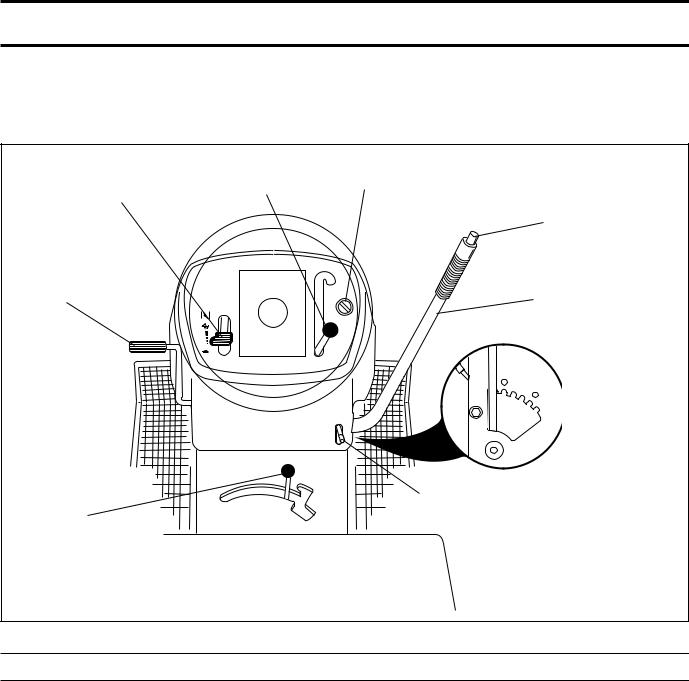
OPERATION
KNOW YOUR TRACTOR
READ THIS OWNER'S MANUAL AND SAFETY RULES BEFORE OPERATING YOUR TRACTOR
Compare the illustrations with your tractor to familiarize yourself with the locations of various controls and adjustments. Save this manual for future reference.
ATTACHMENT
CLUTCH LEVER IGNITION
SWITCH
THROTTLE/CHOKE CONTROL
LIFT LEVER PLUNGER
CLUTCH/BRAKE PEDAL |
ATTACHMENT |
|
LIFT LEVER |
MOWER DECK
HEIGHT ADJUSTMENT
POSITIONS
PARKING BRAKE
GEARSHIFT
LEVER
02629
FIG. 4
Our tractors conform to the safety standards of the American National Standards Institute.
ATTACHMENT CLUTCH LEVER - Used to engage the mower blades, or other attachments mounted to your tractor.
THROTTLE/CHOKE CONTROL - Used for starting and controlling engine speed.
CLUTCH/BRAKE PEDAL - Used for declutching and braking the tractor and starting the engine.
PARKING BRAKE - Locks clutch/brake pedal into the brake position.
GEARSHIFT LEVER - Selects the speed and direction of tractor.
ATTACHMENT LIFT LEVER - Used to raise, lower, and adjust the mower deck or other attachments mounted to your tractor.
LIFT LEVER PLUNGER - Used to release attachment lift lever when changing its position.
IGNITION SWITCH - Used for starting and stopping the engine.
10
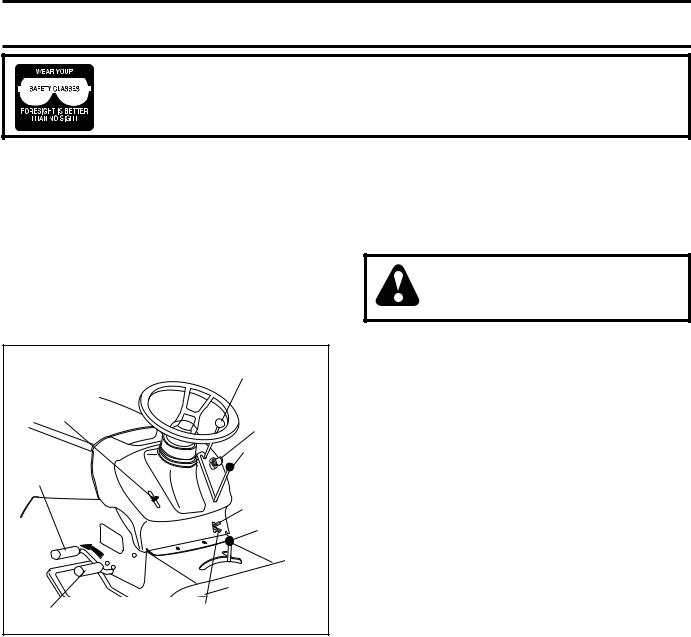
OPERATION
The operation of any tractor can result in foreign objects thrown into the eyes, which can result in severe eye damage. Always wear safety glasses or eye shields while operating your tractor or performing any adjustments or repairs. We recommend a wide vision safety mask over spectacles or standard safety glasses.
00155
HOW TO USE YOUR TRACTOR
TO SET PARKING BRAKE (See Fig. 5)
Your tractor is equipped with an operator presence sensing switch. When engine is running, any attempt by the operator to leave the seat without first setting the parking brake will shut off the engine.
•Depress clutch/brake pedal into full “BRAKE” position and hold.
•Place parking brake lever in “ENGAGED” position and release pressure from clutch/brake pedal. Pedal should remain in “BRAKE” position. Make sure parking brake will hold tractor secure.
IMPORTANT: LEAVING THE IGNITION SWITCH IN ANY POSITION OTHER THAN "OFF" WILL CAUSE THE BATTERY TO BE DISCHARGED, (DEAD).
NOTE: Under certain conditions when tractor is standing idle with the engine running, hot engine exhaust gases may cause “browning” of grass. To eliminate this possibility, always stop engine when stopping tractor on grass areas.
CAUTION: Always stop tractor completely, as described above, before leaving the operator's position; to empty grass catcher, etc.
ATTACHMENT CLUTCH LEVER "ENGAGED" POSITION
THROTTLE/CHOKE
CONTROL LEVER
IGNITION KEY
TO USE THROTTLE CONTROL (See Fig. 5)
Always operate engine at full throttle.
•Operating engine at less than full throttle reduces the battery charging rate.
•Full throttle offers the best bagging and mower performance.
"BRAKE" POSITION
01995
"DISENGAGED" POSITION
PARKING BRAKE "ENGAGED" POSITION
GEARSHIFT
LEVER
CLUTCH/BRAKE PEDAL |
PARKING BRAKE |
"DRIVE" POSITION |
"DISENGAGED" POSITION |
|
FIG.5 |
STOPPING (See Fig. 5)
MOWER BLADES -
•To stop mower blades,move attachment clutch lever to “DISENGAGED” position.
GROUND DRIVE -
•To stop ground drive, depress clutch/brake pedal into full “BRAKE” position.
•Move gearshift lever to neutral (N) position. ENGINE -
•Move throttle control between half and full speed (fast) position.
NOTE: Failure to move throttle control between half and full speed (fast) position, before stopping may cause engine to “backfire”.
•Turn ignition key to “STOP” position and remove key. Always remove key when leaving tractor to prevent unauthorized use.
• Never use choke to stop engine. |
11 |
TO MOVE FORWARD AND BACKWARD (See Fig. 5)
The direction and speed of movement is controlled by the gearshift lever.
•Start tractor with clutch/brake pedal depressed and gearshift lever in neutral (N) position.
•Move gearshift lever to desired position.
•Slowly release clutch/brake pedal to start movement.
IMPORTANT: BRING TRACTOR TO A COMPLETE STOP BEFORE SHIFTING OR CHANGING GEARS. FAILURE TO DO SO WILL SHORTEN THE USEFUL LIFE OF YOUR TRANSAXLE.
TO ADJUST MOWER CUTTING HEIGHT (See Fig. 5)
The position of the attachment lift lever determines the cutting height.
•Grasp lift lever.
•Press plunger with thumb and move lever to desired position.
The cutting height range is approximately 1-1/2 to 4". The heights are measured from the ground to the blade tip with the engine not running. These heights are approximate and may vary depending upon soil conditions, height of grass and types of grass being mowed.
•The average lawn should be cut to approximately 2-1/2 inches during the cool season and to over 3 inches during hot months. For healthier and better looking lawns, mow often and after moderate growth.
•For best cutting performance, grass over 6 inches in height should be mowed twice. Make the first cut relatively high; the second to desired height.

OPERATION
TO OPERATE MOWER (See Fig. 6)
Your tractor is equipped with an operator presence sensing switch. Any attempt by the operator to leave the seat with the engine running and the attachment clutch engaged will shut off the engine.You must remain fully and centrally positioned in the seat to prevent the engine from hesitating or cutting off when operating your equipment on rough, rolling terrain or hills.
•Select desired height of cut.
•Start mower blades by engaging attachment clutch control.
•TO STOP MOWER BLADES - disengage attachment clutch control.
CAUTION: Do not operate the mower without either the entire grass catcher, on mowers so equipped,or the deflector shield in place.
ATTACHMENT LIFT
LEVER HIGH
POSITION
"ENGAGED" POSITION
LOW
POSITION
ATTACHMENT CLUTCH LEVER "DISENGAGED" POSITION
0199 |
DEFLECTOR |
|
4 |
||
|
SHIELD
FIG. 6
TO OPERATE ON HILLS
WARNING: Do not drive up or down hills with slopes greater than 15° and do not drive across any slope.
•Choose the slowest speed before starting up or down hills.
•Avoid stopping or changing speed on hills.
•If slowing is necessary, move throttle control lever to slower position.
•If stopping is absolutely necessary, push clutch/brake pedal quickly to brake position and engage parking brake.
•Move gearshift lever to 1st gear. Be sure you have allowed room for tractor to roll slightly as you restart movement.
•To restart movement, slowly release parking brake and clutch/brake pedal.
•Make all turns slowly.
TO TRANSPORT
•Raise attachment lift to highest position with attachment lift control.
•When pushing or towing your tractor, be sure gearshift lever is in neutral (N) position.
•Do not push or tow tractor at more than five (5) MPH.
NOTE: To protect hood from damage when transporting your tractor on a truck or a trailer, be sure hood is closed and secured to tractor. Use an appropriate means of tying hood to tractor (rope, cord, etc.).
TOWING CARTS AND OTHER ATTACHMENTS
Tow only the attachments that are recommended by and comply with specifications of the manufacturer of your tractor. Use common sense when towing. Too heavy of a load, while on a slope, is dangerous. Tires can lose traction with the ground and cause you to lose control of your tractor.
BEFORE STARTING THE ENGINE
CHECK ENGINE OIL LEVEL
•The engine in your tractor has been shipped, from the factory, already filled with summer weight oil.
•Check engine oil with tractor on level ground.
•Remove oil fill cap/dipstick and wipe clean, reinsert the dipstick and screw cap tight, wait for a few seconds, remove and read oil level. If necessary, add oil until “FULL” mark on dipstick is reached. Do not overfill.
•For cold weather operation you should change oil for easier starting (See “OIL VISCOSITY CHART” in the Maintenance section of this manual).
•To change engine oil, see the Maintenance section in this manual.
ADD GASOLINE
•Fill fuel tank to bottom of filler neck. Do not overfill. Use fresh, clean, regular unleaded gasoline with a minimum of 87 octane. (Use of leaded gasoline will increase carbon and lead oxide deposits and reduce valve life). Do not mix oil with gasoline. Purchase fuel in quantities that can be used within 30 days to assure fuel freshness.
CAUTION: Wipe off any spilled oil or fuel. Do not store, spill or use gasoline near an open flame.
IMPORTANT: WHEN OPERATING IN TEMPERATURES BELOW32°F(0°C), USE FRESH, CLEAN WINTER GRADE GASOLINE TO HELP INSURE GOOD COLD WEATHER STARTING.
12
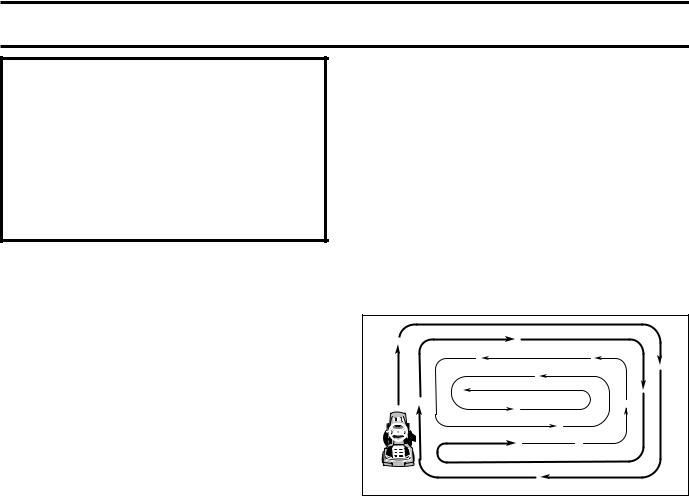
OPERATION
CAUTION: Alcohol blended fuels (called gasohol or using ethanol or methanol) can attract moisture which leads to separation and formation of acids during storage. Acidic gas can damage the fuel system of an engine while in storage. To avoid engine problems, the fuel system should be emptied before storage of 30 days or longer. Drain the gas tank, start the engine and let it run until the fuel lines and carburetor are empty. Use fresh fuel next season. See Storage Instructions for additional information. Never use engine or carburetor cleaner products in the fuel tank or permanent damage may occur.
TO START ENGINE (See Fig. 5)
When starting the engine for the first time or if the engine has run out of fuel, it will take extra cranking time to move fuel from the tank to the engine.
•Sit on seat in operating position, depress clutch/brake pedal and set parking brake.
•Place gear shift lever in neutral (N) position.
•Move attachment clutch to “DISENGAGED” position.
•Move throttle control to choke position.
NOTE: Before starting, read the warm and cold starting procedures below.
•Insert key into ignition and turn key clockwise to“START” position and release key as soon as engine starts. Do not run starter continuously for more than fifteen seconds per minute. If the engine does not start after several attempts, move throttle control to fast position, wait a few minutes and try again. If engine still does not start, move the throttle control back to the choke position and retry.
WARM WEATHER STARTING (50° F and above)
•When engine starts, move the throttle control to the fast position.
•The attachments and ground drive can now be used. If the engine does not accept the load, restart the engine and allow it to warm up for one minute using the choke as described above.
COLD WEATHER STARTING ( 50° F and below)
•When engine starts, allow engine to run with the throttle control in the choke position until the engine runs roughly, then move throttle control to fast position. This may require an engine warm-up period from several seconds to several minutes, depending on the temperature.
•The attachments can also be used during the engine warm-up period.
NOTE: If at a high altitude (above 3000 feet) or in cold temperatures (below 32 F) the carburetor fuel mixture may need to be adjusted for best engine performance. See “TO ADJUST CARBURETOR” in the Service and Adjustments section of this manual.
MOWING TIPS
•Tire chains cannot be used when the mower housing is attached to tractor.
•Mower should be properly leveled for best mowing performance. See “TO LEVEL MOWER HOUSING” in the Service and Adjustments section of this manual.
•The left hand side of mower should be used for trimming.
•Drive so that clippings are discharged onto the area that has been cut. Have the cut area to the right of the machine. This will result in a more even distribution of clippings and more uniform cutting.
•When mowing large areas, start by turning to the right so that clippings will discharge away from shrubs, fences, driveways, etc. After one or two rounds, mow in the opposite direction making left hand turns until finished (See Fig. 7 ).
00272 |
FIG. 7
•If grass is extremely tall, it should be mowed twice to reduce load and possible fire hazard from dried clippings. Make first cut relatively high; the second to the desired height.
•Do not mow grass when it is wet. Wet grass will plug mower and leave undesirable clumps. Allow grass to dry before mowing.
•Always operate engine at full throttle when mowing to assure better mowing performance and proper discharge of material. Regulate ground speed by selecting a low enough gear to give the mower cutting performance as well as the quality of cut desired.
•When operating attachments, select a ground speed that will suit the terrain and give best performance of the attachment being used.
13
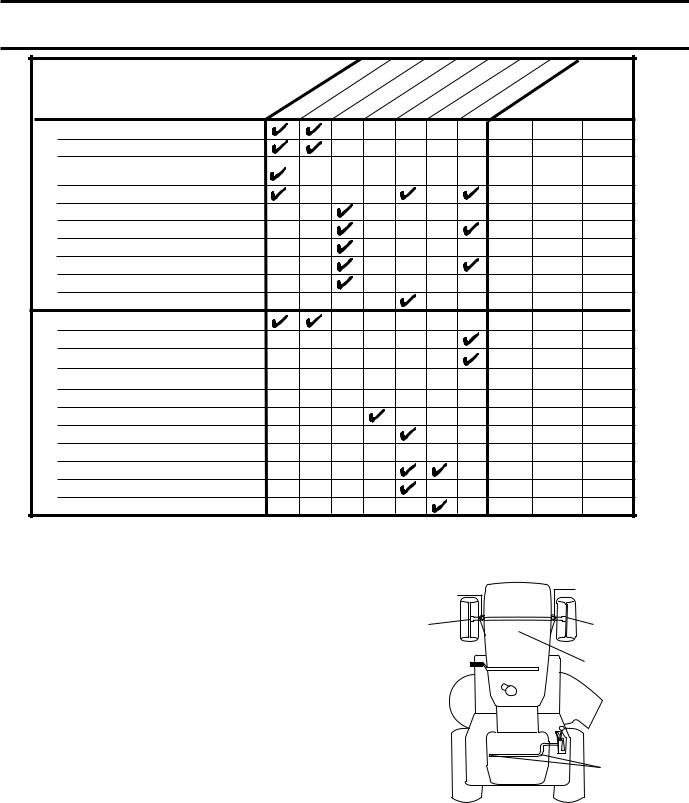
MAINTENANCE
MAINTENANCE SCHEDULE
FILL IN DATES
AS YOU COMPLETE
REGULAR SERVICE
|
Check Brake Operation |
|
Check Tire Pressure |
T |
Check Operator Presence and |
Interlock Systems |
|
R |
Check for Loose Fasteners |
A |
Sharpen/Replace Mower Blades |
C |
Lubrication Chart |
T |
|
0 |
Check Battery Level |
R |
Clean Battery and Terminals |
|
Check Transaxle Cooling |
|
Check V-Belts |
|
Check Engine Oil Level |
|
Change Engine Oil (with oil filter) |
E |
Change Engine Oil (without oil filter) |
N |
Clean Air Filter |
G |
Clean Air Screen |
I |
Inspect Muffler/Spark Arrester |
N |
Replace Oil Filter (If equipped) |
E |
|
|
Clean Engine Cooling Fins |
|
Replace Spark Plug |
|
Replace Air Filter Paper Cartridge |
|
Replace Fuel Filter |
|
|
HOURS |
|
|
HOURS |
STORAGE |
||
USE |
|
HOURSHOURS |
SEASON |
|
||
EACH 8 |
|
|
||||
25 |
50 |
100 |
|
|||
BEFOREEVERY EVERY EVERYEVERY EVERYBEFORE |
SERVICE DATES |
|||||
5
3
4
 1,2
1,2
 1,2
1,2
 2
2
 2
2
1, 2
 2
2
2
1 |
- Change more often when operating under a heavy load or |
3 |
- Replace blades more often when mowing in sandy soil. |
|
in high ambient temperatures. |
4 |
- Not required if equipped with maintenance-free battery. |
2 |
- Service more often when operating in dirty or dusty conditions. |
5 |
- Tighten front axle pivot bolt to 35 ft.-lbs. maximum. |
|
|
|
Do not overtighten. |
new1.tractore-sch_maint
GENERAL RECOMMENDATIONS
The warranty on this tractor does not cover items that have been subjected to operator abuse or negligence. To receive full value from the warranty, operator must maintain tractor as instructed in this manual.
Some adjustments will need to be made periodically to properly maintain your tractor.
At least once a season, check to see if you should make any of the adjustments described in the Service and Adjustments section of this manual.
•At least once a year you should replace the spark plug, clean or replace air filter, and check blades and belts for wear. A new spark plug and clean air filter assure proper air-fuel mixture and help your engine run better and last longer.
BEFORE EACH USE
•Check engine oil level.
•Check brake operation.
•Check tire pressure.
•Check operator presence and interlock systems for proper operation.
•Check for loose fasteners.
|
LUBRICATION CHART |
|
SPINDLE |
SPINDLE ZERK |
|
ZERK |
FRONT |
|
FRONT |
||
WHEEL BEARING |
||
WHEEL |
ZERK |
|
BEARING |
||
|
||
ZERK |
ENGINE |
|
|
GEARSHIFT
PIVOTS
01961
SAE 30 OR 10W30 MOTOR OIL
GENERAL PURPOSE GREASE
REFER TO MAINTENANCE “ENGINE” SECTION
IMPORTANT: DO NOT OIL OR GREASE THE PIVOT POINTS WHICH HAVE SPECIAL NYLON BEARINGS. VISCOUS LUBRICANTS WILL ATTRACT DUST AND DIRT THAT WILL SHORTEN THE LIFE OF THE SELF-LUBRICATING BEARINGS. IFYOU FEEL THEY MUST BE LUBRICATED, USE ONLY A DRY, POWDERED GRAPHITE TYPE LUBRICANT SPARINGLY.
14
